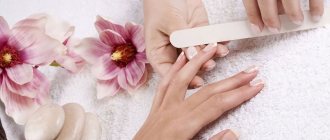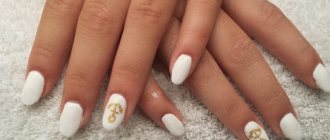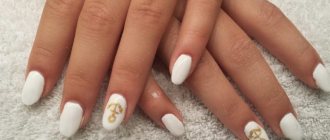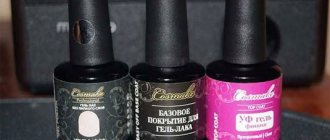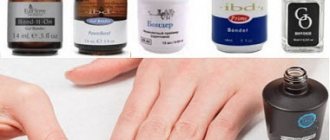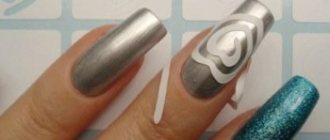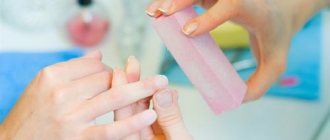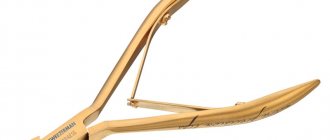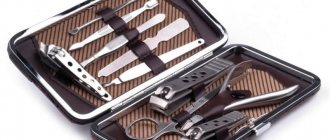Application
Buff from English buff, polish - a special file in the form of a three-dimensional rectangular block, each face of which has its own abrasiveness.
The main functions of this tool are grinding and polishing natural and extended nail plates, from which it removes irregularities and minor flaws. A polished, smooth surface of the nail improves adhesion between the artificial and natural plates and allows for better placement of material during the process of extension or pigmentation. You can also use a buff to remove rough skin from the periungual ridges, hangnails, cuticles and seal detachments of the plate. It is for this important stage in creating a manicure that a buff is used, both in the salon and at home.
It is convenient to carry the Bafik in your purse so that this indispensable tool, which solves so many problems, is always at hand. It is customary to number the four working surfaces of the tool so as not to confuse what actions can be performed by each of them. At home, you can replace several nail files with this universal buff:
- the first edge creates the shape of the nail, removes the length;
- the second edge removes unevenness, roughness, and can remove burrs;
- the third face polishes, removes minor imperfections and flaws;
- fourth - polishes the nail to a shiny state.
The best files for natural nails
The category offers a wide selection of metal, glass and ceramic files for the care of natural nails. All accessories are of high quality, durable and tolerate various methods of disinfection.
Royal Tools file with sealing effect
5
★★★★★
editorial assessment
100%
buyers recommend this product
This innovative nail file has already captivated many manicurists. It is made of high quality steel and impact-resistant plastic. The shape is oval and slightly curved - for convenient filing of edges.
The sides have different abrasiveness: the first is suitable for length correction, the second, smoother, is for grinding and sealing the edges of the nail. The use of such an accessory stops delamination and prevents chemicals from getting inside the plate.
Pros:
- High-quality manufacturing materials;
- Comfortable handle and curved shape of the file itself;
- Hard storage case;
- Removes length and seals the edge of the nail;
- Sides with different abrasiveness.
Minuses:
- It costs expensive.
The premium English brand Royal Tools produces professional manicure tools. Only high-quality materials and new technologies are used for products, thanks to which they last for years.
Zwilling JA Henckels Ceramic 88418
4.9
★★★★★
editorial assessment
95%
buyers recommend this product
A shaped nail file with a wide plastic holder is considered one of the safest. The work area is made of ceramic in the form of a rectangle. The corners are quite sharp and make it easy to trim your nails and also seal their edges.
This device can be used to treat cuticles, nail folds, and even remove hangnails. The handle has a pleasant and discreet pastel shade: blue, pink, white or blue - your choice.
Pros:
- Wide comfortable handle;
- Safe ceramic file;
- Suitable for caring for fragile, brittle nails and cuticles;
- Seals the edge;
- Lightweight and durable.
Minuses:
- The price is a bit high;
- The non-standard handle takes some getting used to.
To prevent your nails from deteriorating and peeling, you need to take proper care of them. This accessory will help you with this. Ceramics with fine and uniform grain size are safe for the health of nails, and also quickly remove length and give the desired shape.
Silver Star AT 467
4.8
★★★★★
editorial assessment
90%
buyers recommend this product
Silver Star products are no less in demand. It produces inexpensive and convenient tools, including nail files. Model AT467 is made of a ceramic bar placed in a plastic case.
On the opposite side there is a narrow pencil file for caring for the cuticle and skin around the nail. The ideal result is achieved by steaming your fingers and carefully filing.
Pros:
- Compact and convenient model;
- Ceramic base;
- Closes with a plastic cap;
- There is an ISO quality certificate;
- Does not break when dropped;
- The work area is not cut down for a long time.
Minuses:
- Over time, the mount becomes loose and the file falls out of the case;
- The cap is easily scratched.
All brand products are certified and meet European standards. The quality of the tool is excellent, but you should not be overzealous when using it, otherwise the skin will become inflamed and hangnails will appear.
Laser file Mertz 140
4.7
★★★★★
editorial assessment
87%
buyers recommend this product
The file is made of steel and has an innovative laser coating for gentle cutting. The sharp corners do an excellent job of correcting the plate in hard-to-reach places, and also serve as the prevention of ingrown toenails.
The instrument is popular among professional craftsmen and ordinary girls. It can be sterilized and treated with various chemical disinfectants. For convenience, there is a plastic handle on the edge.
Pros:
- Suitable for salon and home use;
- Quality materials;
- The right angles of the tool cope with cutting in hard-to-reach places;
- Suitable for removing cuticles;
- Sterilization allowed;
- Inexpensive.
Minuses:
- Roughly affects the nail and leaves roughness;
- No storage case.
The model is small and compact - it will easily fit in a purse or purse. But, like any manicure tool, you need to get used to it.
READ ALSO
5 Best Nail Extension Kits
Kinds
Buffers, which have the shape of a bar 6-10 centimeters long, also include two more types of special files:
- Grinder has an elongated shape with a wide working surface. More often used in salon settings, the abrasiveness of the sides is suitable for natural and extended nails;
- The polisher has a similar shape, but the working surface is smooth to the touch. It is also convenient for sealing detachments.
Abrasiveness
The abrasiveness of the buffer determines the hardness of the sides and shows for what type of nails it is best to use it and what functions it performs. Depending on the abrasiveness index, there is the following classification:
- 60-80 grit – suitable for pedicure and working with artificial nails;
- 100-150 grit – for polishing nails during pedicure, for correcting the surface of an artificial plate before applying gel polish;
- 150-240 grit – to give the desired length and shape to natural nails, for polishing extended nails;
- 300 grit and more - used for delicate polishing of natural nails to a natural shine.
The best files for artificial nails
Only a wide, coarse-grain file can level acrylic bumps and mounds, while a finer file will help to polish and give the ideal shape.
Zinger EJ-212 sandpaper
4.9
★★★★★
editorial assessment
92%
buyers recommend this product
A file with a grit of 120-180 is used for processing artificial nails, cutting down irregularities and giving shape. Both sides are covered with sandpaper in bright rainbow colors and do the job perfectly. The base is flexible and does not break when bent (if you are not zealous), the edges fray over time, but this is the fate that awaits most of these models.
Pros:
- Neat, comfortable shape;
- Bright colors;
- Flexible base;
- 2 sides of rigidity;
- Suitable for acrylic and gel nails;
- High quality and at the same time inexpensive.
Minuses:
- The edges fray over time;
- The water makes the sandpaper peel off from the base.
This type of file is used by both masters and beginners. It is easy to use, fits easily in the hand, and the flexibility of the base allows you to slightly bend the file between your fingers when shaping artificial nails.
Kodi Professional Half
4.8
★★★★★
editorial assessment
89%
buyers recommend this product
In second place is the popular “banana” shape file. One of its edges is straight, and the other is curved, which allows you to approach the nail from all sides and form it correctly.
The manufacturer's assortment includes similar models with different grain sizes: from 80 to 240 grit. The 180/240 grit file is suitable for caring for all types of nails; it does not injure the edge, but also does not seal it like a ceramic one.
Pros:
- Convenient shape;
- Double-sided files with different abrasiveness;
- Flexible base;
- Convenient when working with acrylic and gel materials.
Minuses:
- Boring gray color;
- With frequent use, it quickly cuts down.
While the 180/240 model performs well, coarser-grain files damage and burn the skin. Otherwise, there are no complaints about them: the shape is comfortable, the sawdust is neat, and does not leave burrs.
Irisk Professional set of nail files plus buff polisher
4.7
★★★★★
editorial assessment
86%
buyers recommend this product
For beginners and those who want to upgrade their manicure tools, the Irisk Professional brand offers a set of three files with abrasiveness 100/100, 100/180 and 240/240, as well as a three-sided polishing buffer 320/4000 grit.
The files included are neat, thin, and fit comfortably in the palm of your hand. One of them has a “banana” shape for wide coverage of the gash area. The polisher is presented in the form of a triangle.
Pros:
- A well-equipped set with files of different shapes and grain sizes;
- Suitable for artificial and natural nails;
- The files are flexible and fit comfortably in the hand;
- Excellent workmanship.
Minuses:
- The polisher is inconvenient;
- The files are too thick to correct short natural nails.
The coating of the nail files is strong and durable, but wears off quickly with frequent use. And using a 100 grit file can cause burrs. You need to know how to handle such a set.
Studio Style 45727
4.5
★★★★★
editorial assessment
82%
buyers recommend this product
To change the length and primary treatment of acrylic nails, a file with 80/100 grit is suitable. It copes with the task perfectly: it cuts down bumps and irregularities, after which all that remains is to carry out the final grinding. The model will be useful for correction and careful cutting of material. The base is made of flexible plastic and covered with sprayed paper.
Pros:
- Thin, comfortable;
- Used for correction and extension;
- Quickly removes excess length and gives shape;
- Flexible base;
- Bright colors.
Minuses:
- The edges quickly fray and the coating wears off;
- Doesn't file well under the nail.
When disinfecting this file, problems may arise: the glued sandpaper is afraid of water and aggressive chemicals, and also quickly wears off on the edges, while the middle remains intact.
READ ALSO
12 best manicure sets
What materials?
The working surface of the buff differs not only in abrasiveness, but also in the material from which the sides of the tool are made. Depending on this, buffs are of the following types:
- Polyethylene foam or plastic are the most affordable, durable, and therefore the most popular. Can be sterilized;
- Silicone - durable, inexpensive, easy to clean and sterilize;
- Suede - average quality, more expensive than plastic and silicone, cannot be sterilely processed;
- Fabric ones are of high quality, suitable for working with natural nails, flexible, elastic, impossible to disinfect. Silk coating is considered the most expensive.
The base of the buffers is also made of various materials. It can be fabrics, wood, plastic. The shape of the buffers is not very different. Basically these are rectangular bars with two or four working surfaces. Sometimes there are buffs in the form of a boomerang, small square bars.
Terms of use
To avoid injury to the structure of the natural nail, damage to the surface of the artificial plate and to obtain a high-quality manicure, you must adhere to a few simple rules when working with a buffer:
- Choose the right side of the buff, with the required abrasiveness.
- You need to apply the tool to the nail plate with the wide side so that the surface of the buff covers as much of the surface of the nail as possible.
- Long movements of the buff along the nail surface should be directed in one direction, for example, from right to left or from the cuticle area to the free edge. Chaotic movements are not desirable, and there should not be a lot of them.
- It is recommended to use the buffer no more than once a week so as not to thin the natural plate.
- Once or twice a month you need to rub nourishing oil into the nail as a buff. This is done to strengthen and seal.
- It is necessary to periodically reprocess the tool.
Nail lamination - procedure and review of products
The surface of the nail is sanded before applying both regular nail polish and gel polish. Therefore, you should think about purchasing a high-quality tool that will not harm your nails or ruin your manicure.
The process of proper grinding and polishing using a buffer can be seen in the video
Wearing methods
There are the following universal options for wearing the product, suitable for both men and women:
1. Scarf. This is the most common and simplest method. When wearing an accessory around the neck, you can protect delicate skin from sun rays, piercing wind and cold.
2. Mask. The bandage is put on in the same way as in the previous version, only in this case one part of it is pulled up to the nose. This results in a comfortable mask that will protect the respiratory system from cold air (but it should not be used as protection against Covid-19).
3. Bandana. This is a great option for wearing in the summer (if you use a buff made from light fabric). To tie a bandana, you will need to turn the product inside out, put your hand inside and place it on your forehead, and then pull the edge of the bandana over your head with the other hand. The free edge, which hangs down at the back, will provide additional protection to the neck from ultraviolet rays.
4. Hat. To put on the bandage this way, you should turn it inside out, then insert it inside your palm from both edges, spreading your fingers slightly. After this, marking the center, make rotational movements with your hand and turn the product back out. The result is a two-layer hat.
5. Wristband. The next option for wearing a buff is to wrap it in several layers around the wrist. This is great for running - the wristband is convenient for wiping sweat from your forehead.
In the photo below you can see the presented options in more detail.
For women
Representatives of the fair sex can wear this multifunctional headband both on the head and on the neck, using it as:
- headscarves - perfect for long-haired girls to prevent their hair from becoming disheveled and in the way;
- hair bands;
- scarf;
- forehead bandages.
Some brave girls sometimes wear a buff as a top.
Processing and disinfection
Like any other manicure equipment that comes into contact with the skin when treating hands and nails, buffers also need to be treated periodically. As we have already found out, not all buffs can be sterilized and disinfected. Therefore, it is better to use fabric and suede instruments personally, exclusively at home.
Plastic and silicone tools are easy to process. In salons, ultraviolet bactericidal lamps and sterilizers are used for this purpose. At home, it is enough to wash the buffs in a soapy solution. Fabric buffers that allow water to pass through can be rinsed in any disinfectant solution, but there is a high probability that the functionality of the instrument will become worse. Typically, fabric buffs are replaced after a certain time.
How and with what to disinfect, sterilize and clean manicure instruments
Caring for manicure buffs
Not only your nails, but also any manicure instrument needs care. Over time, germs, dirt, and various pathogenic microorganisms accumulate on the polishing blocks, so do not neglect treatment with disinfectants. However, this is not always easy to do, since buffs absorb water excessively.
It is recommended to choose varieties that are the least difficult to care for. For example, fabric buffs have a very short shelf life. It is not recommended to get them wet, as they deform and delaminate very quickly. Plastic analogues are much more convenient in this regard. They last longer and are much easier to disinfect.
If you still don’t have a buff in your arsenal of manicure tools, then be sure to purchase one. It will become an indispensable assistant for you in nail care. In the meantime, we invite you to watch a very useful video from which you will learn all the tricks of sealing peeling nails using a manicure buff.
How to choose
To choose a quality tool for polishing and grinding nails, you need to pay attention to the following factors:
- The material from which the buff is made. It is best to choose a material that is wear-resistant and easy to process;
- Abrasiveness. If you are going to process only natural nails, then there is no need to purchase a tool with an abrasiveness of less than 150 grit. And vice versa, if you are working with extended nails, then a buff with a hardness of more than 300 grit will simply lie idle;
- Color. Of course, the shade of the tool does not affect the functionality and result of the work, but it does improve your mood while working on your nails. Manufacturers of nail industry equipment offer a wide range of color solutions;
- Manufacturer's brand. It is best to choose tools from reliable manufacturers of quality products.
This video can help you choose tools for polishing.
How can I replace a buffer for nail treatment?
Buff is a necessary tool, the emergence of which was facilitated by the development of the technological process. If in a certain situation such a tool is not at hand, then you can use an ordinary file with the appropriate abrasiveness, but this will not guarantee a high-quality result. As a last resort, you can resort to improvised methods, taking, for example, a piece of coarse fabric. In any case, a grinding device should be present at the initial and final stages of manicure - both regular and using gel polish.
Review of quality brands
Let's look at some popular, proven brands that are distinguished by their quality and ease of use.
- Titania 1205B - a universal file for natural and artificial nails has three sides with different abrasiveness and for different tasks - length correction and roughening, removing grooves on the nail plate or polishing;
- Planet Nails - a four-sided buffer with varying degrees of abrasiveness will help polish, correct and level the surface of the nail. The polishing side helps give nails shine, and can be used with oil to enhance the lamination effect;
- Zinger. The BA-10 buff, like the previous one, has 4 working sides - from 180 to 3000 grit. Durable model - does not crumble or crumble for a long time;
- OPI Shiner is a double-sided polisher that gives your nails a healthy shine in a short period of time without any oils;
- CND Koala – a tool with abrasiveness of 240 and 1000 grit for grinding and polishing natural nails;
- Creative Block – buffer for natural, extended nails;
- IBD Diamond – for polishing gel and acrylic nails;
- Premier is a buff with three sides of different abrasiveness for grinding and polishing natural nails.
Now you know what buffs are and how to choose them.
What brand of buff do you use? We are waiting for your answer in the comments. Comment
What are buffs?
The file and buff work the same way, both act as a nail polisher. But still, these two instruments are distinguished by the density of the grain structure. Buffs are less abrasive than files. It can be used for both natural nails and artificial coating. A small rectangular block performs many tasks.
Used in beauty salons and at home.
The base of the buff can be wooden, plastic, or even fabric. The sanding area can be suede, silicone or any other.
Buff is divided into several types based on abrasiveness.
- Abrasive from sixty to eighty, coarse, hard - suitable for use on artificial surfaces.
- One hundred to one hundred and fifty grits are suitable for pedicure polishing, processing
- An abrasiveness of one hundred and fifty to two hundred and forty grits is used to correct the shape of the tips of natural nails or to polish artificial surfaces.
- From three hundred grit – gentle and fine-grained. They are used to polish natural nails.
Buffs are three-dimensional rectangular bars. For convenience, each side has a number from one to four. This helps avoid confusion while working. Each part of the buff is used for a different purpose:
- Giving shape, imitation of a simple file.
- Gently smoothes the nail surface.
- Grinds and removes minor irregularities.
- Gives final shine and smoothness.
